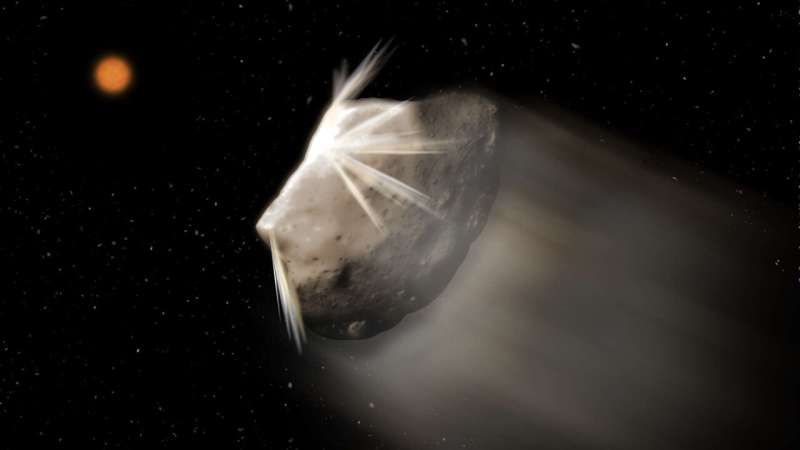This article has been reviewed according to Science X's editorial process and policies. Editors have highlighted the following attributes while ensuring the content's credibility:
fact-checked
peer-reviewed publication
trusted source
proofread
Centaurs gain comet-like characteristics through close encounters with Jupiter, Saturn

A rapid reshaping of orbits resulting from a close encounter with Jupiter or Saturn can lead Centaurs to exhibit comet-like activity, according to a Planetary Science Institute Senior Scientist Eva Lilly paper.
Centaurs are small bodies similar to asteroids in size but to comets in composition that revolve around the sun in the outer solar system, mainly between the orbits of Jupiter and Neptune.
"We have found some answers to the long-standing mystery of why some Centaurs became active like comets while the rest appear like regular quiet asteroids. Nobody knew why they behaved this way. It did not make any sense.
There was no correlation with size, color or even the types of orbits," said Lilly, lead author of "Semi-major Axis Jumps as the Activity Trigger in Centaurs and High-Perihelion Jupiter Family Comets" that appears in the Astrophysical Journal Letters. PSI Scientists Kat Volk, Jordan Steckloff, and Henry Hsieh are co-authors.
"In our work we have studied the dynamical history of all known Centaurs, both active and inactive, and coupled our findings with thermal modeling. We were interested in finding some kind of pattern common for active Centaurs that the inactive bodies in the population were lacking. Mapping the dynamical history of Centaurs is a tricky feat—they orbit in the realm of giant planets, and their orbital evolution is governed by the chaotic influence of the giant's gravitational pull," Lilly said.
"We used a numerical integrator—a code that can predict how the orbit of a celestial body evolves, but for Centaurs, this can only be known for a short period of time—typically several hundred years, after which the chaos makes the predictions inaccurate. We found out all active Centaurs underwent a close encounter with either Jupiter or Saturn and that this encounter caused a large orbital change, which we call the 'a-jump.'
"The a-jump is mostly a decrease in the semi-major axis of the Centaur's orbit while at the same time reshaping it from elliptical to more circular and lower perihelion orbits. This change is very rapid—on the order of several months, and the semi-major axis can decrease by several astronomical units," Lilly said.
"The a-jump then effectively places the affected Centaurs on orbits where their surfaces can warm up for a longer time, and this way, the thermal wave can reach ices in the interior, which will then sublimate and effectively turn the Centaur active. Centaurs are icy by nature; they originate in the Kuiper belt of small bodies beyond Neptune but spend most of their dynamic lifetime in the far regions of the solar system where the environment is too cold for the water and other ices to sublimate."
"They are effectively being stored in a freezer," Lilly said. "A-jumps simply move some of them swiftly closer to the sun, where it is warm enough for the ice to undergo phase transitions such as sublimation and turn Centaur into a comet. Our thermal model confirms this. Our results suggest that every Centaur by nature has the ability to become active, but it all depends on how its orbit evolves."
Activity has been observed in only about 10% of Centaurs, and it has not been clear why until now. All Jupiter-family Comets are periodically active and behave like regular comets for the most part.
"We suggest the a-jumps could, therefore, be a major trigger of cometary activity on Centaurs and JFCs. Our results further imply that analyses of the recent dynamical histories could be used to identify objects that are currently active or may become active soon, where we have identified three such Centaurs with recent a-jumps that should be considered high-priority targets for observational monitoring to search for activity," Lilly said.
More information: Eva Lilly et al, Semimajor-axis Jumps as the Activity Trigger in Centaurs and High-perihelion Jupiter-family Comets, The Astrophysical Journal Letters (2024). DOI: 10.3847/2041-8213/ad1606
Journal information: Astrophysical Journal Letters
Provided by Planetary Science Institute





















